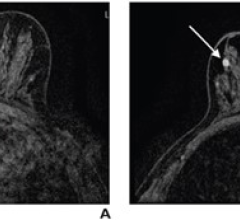
June 12, 2009 - Enlargement and abnormalities of axillary sentinel lymph nodes located in the armpit area near the breast are predictive of cancer, according to initial research conducted at University of Florida Shands Cancer Center and published in the Journal of Magnetic Resonance Imaging. What more accurately indicates the spread of disease is the loss of a key part of a normal node's structure called the fatty hilum that more accurately signals the spread of disease, not the size of the node or enhancement. "We found that the loss of fatty hilum in an axillary lymph node on MRI correlated with finding the spread of breast cancer in axillary nodes at the time of surgery," said Stephen Grobmyer, M.D., an assistant professor of surgical oncology and endocrine surgery at the UF College of Medicine, who noted that not all nodes without fatty hilum necessarily had cancer. The findings also reinforce the value of using MRI to determine the extent of breast cancer prior to surgery, which is capable of detecting more than 95 percent of invasive breast cancers. The UF study retrospectively examined 56 female patients ranging in age from 30 to 82. All women had a sentinel lymph node biopsy. Fifteen women had cancer in the nodes that required complete removal. Four of eight patients in whom a loss of fatty hilum was seen in an axillary node on MRI were found to have cancerous lymph nodes at the time of their breast surgery. By comparison, only 11 out of 48 patients, or 23 percent, with all fatty hilum in place had cancer. For more information: www.health.ufl.edu


 December 03, 2024
December 03, 2024 








